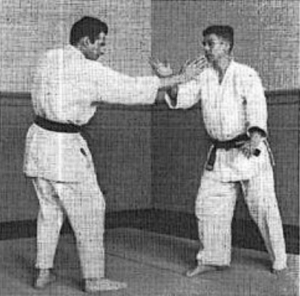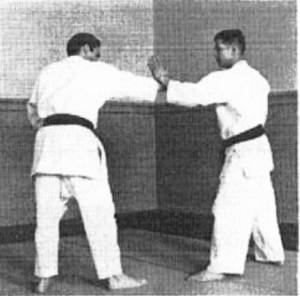Budo Aikido practice provides a safe space where violent actions can be experienced.
In fact the title is misleading, it is not about “breaking”, but is about using opponent’s kamae to start the necessary actions for controlling or throwing. As always when you start a new skill or reviewing an existing skill, the movements are big and in a moderate tempo. After a while, the form and hyoshi will come closer to “a reality”.
What is reality in Budo Aikido?
Any training in the martial arts, if entered into seriously with a sincere mind will make your free play (randori geiko) a reality. Some aggression in you will come forward, and it is your responsibility to control it. Where is this aggression coming from? Maybe you are unhappy with the situation. You like to throw the opponent, but his kamae is too strong, so your solution : break through.
You can choose to fight the person, or you can choose to fight your own negativity and frustration that lead to unhappiness. To revert this unhappiness, we can use the concept of “yielding”. It is not about running away or avoiding, it is about changing the situation into your favor. However, first you have to feel (taikan).
Ishiki 意識
Ishiki has 2 kanji, 意 = I, and 識 = shiki.
“Shiki” means identification, it is the act of recognizing someone or something.
“I” means intent, it is the determination to do something.
In Eastern Martial Arts, the concept of “I” (Yi in Chinese) or intent is the birth of power through the use of “Ki” (Qi or Chi un Chinese). For many Western people, this concept is too metaphysical. However by using this concept and using non-metaphysical words, we can understand the function of it.
Budo Aikido is built on using “Ishiki” or “Consciousness” and utilizing “learned body reflexes”, which are movements created as patterns in the brain through training.
Ishiki is awareness on the conscious level, you are just a conscious observer. The body will react on the input by the feeling and observing action with an appropriate pattern
Breaking through kamae is a matter of ishiki, feel the line of power and act accordingly in a subconscious way by using patterns stored in the brain.
The line of power
Power is traveling along lines using the body. As Budo Aikido movement involves no conscious, intentional use of the muscles, you must not use your consciousness to plan or intend anything. Use your consciousness only to feel. The moment when you touch someone, you can feel his power. Maybe only the power for keeping the posture. Power has a direction, feeling the direction is important. Let your subconscious taking over the action, don’t interfere with local muscle power.
Chudan-no-kamae

Randori-no-kata is an example where chudan-no-kamae is often used. In fact this basic kata is far away from randori geiko. The performance of this kata is a demonstration of concepts useful as training ideas.
The chudan-no-kamae is adopted by uke after a few steps forward. Sometimes in toshu-randori (unarmed freeplay), the opponent is using this kame to close the door, you cannot easily reach the opponent.
By using soto mawashi or uchi mawashi whe can neutralize opponent’s kamae. This is also helpfull when opponent is attacking to your face with shomen ate or frontal attack. After contact with your tegatana on uke’s arm, you can grab the wrist and apply “kuzushi”.
In a more dynamic format, tandoku undo tegatana dosa 1 can be used to practise neutralizing opponent’s forward movement.

The example is one of the many choises you have during the sotai renshu tegatana dosa.
Tegatana dosa 1 & tegatana dosa 2
4 Basic neutralizing approaches
There are 4 basic exercises, 2 ai gamae (regular facing body posture) and 2 gyaku gamae (reverse facing body posture). Soto mawashi and uchi mawashi are used to sweep away uke’s arm. Integrating internal mechanisms will greatly improve the potential of power.
- ai gamae soto mawashi
- ai gamae uchi mawashi
- gyaku gamae soto mawashi
- gyaku gamae uchi mawashi
 Aigamae soto mawashi
Aigamae soto mawashi

 Ai gamae uchi mawashi
Ai gamae uchi mawashi

 Gyaku gamae soto mawashi
Gyaku gamae soto mawashi

 Gyaku gamae uchi mawashi
Gyaku gamae uchi mawashi



3 thoughts on “Breaking through “kamae””